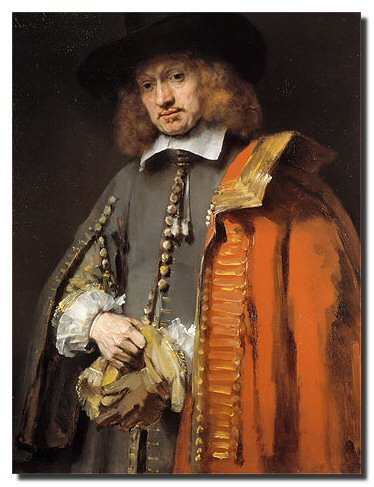|
La Chambre Des Reines
|
Paintings
|
Rembrandt Harmensz. van Rijn 1606-1669 
(click on painting to enlarge) Portrait of Jan Six
Introduction The portrait of Jan Six is not only Rembrandt’s most beautiful likeness or the finest portrait of the seventeenth century. No, to me it is the most beautiful in the entire world. This portrait, like "Portrait of Anna Wijmer", a portrait of his mother that was painted by Rembrandt also, has remained in the Six family's possession since Rembrandt painted it more than 300 years ago and is to be found in the Six house in Amsterdam. A visit to the Six Collection has, for decades, been a mark of achievement for art connoisseurs. It demonstrated knowledge and influence, for only with an introduction from friends or well known experts in the field was it possible to gain admission to the house. Today the house is the residence of Jan Six 10th, an art publisher and father of Jan Six 11th, newly appointed head of Old Masters at Sotheby's Amsterdam. They have their offices downstairs. Several years ago the Six family and the Dutch Government recognized the need to preserve the collection as a national treasure. Under an agreement by which the Government subsidizes the upkeep of the collection in exchange for the family's promise to keep it intact, the public is admitted to view the works, but on a strictly regulated basis. No more than 10 visitors are allowed at one time, with a maximum of 800 a year. The figure of 800 was reportedly reached after calculations were made about the wear and tear on the house's Oriental carpets and parquet floors.
About the portrait Born in Amsterdam, Jan Six came from a noble Huguenot (Protestant) family, which had fled to Amsterdam from France at the end of the 16th century. Six was the youngest son of Jean Six and Anna Wijmer. His father, who died two months before Jan’s birth, had made his fortune in the silk and cloth trade. After his death, Anna continued to run the family business with a firm hand. The profits this generated along with sound real estate investments, made the Sixes one of the wealthiest families in the city. Jan Six received a thorough education. In 1634 he was enrolled in the University of Leiden, where he studied law. He concluded his formal training with a Grand Tour through Italy. Upon his return to Amsterdam he devoted himself to studying, writing poetry and building up an extensive art collection and a library. He did not take part in the family business,
which was managed by his eldest brother, Pieter, after their mother’s
death in 1654. In 1655 he married Margaretha Tulp,
the daughter of the renowned physician Nicolaes Tulp, whereby Six joined
the ruling elite. Six’s powerful father-in-law Tulp also appears in Rembrandt’s world-famous
The
anatomy lesson of Dr Nicolaes Tulp from 1632. Six was a member of the Amsterdam city council
and appointed burgomaster of Amsterdam in 1691. (At the age of 73!) Passionately interested in the arts, particularly poetry, Six was a member of the so-called Muiderkring (Muiden circle) which gathered around the poet Pieter Cornelisz. Hooft and he published volumes of poetry and plays. He was an avid collector of works of art - Dutch and Italian masters, antique sculpture, engraved gems and travelled widely. Six owned a number of paintings by Rembrandt. Their relationship was, however, one of friendship rather than simply that of patron and artist. Rembrandt etched the title page for Six's tragedy Medea and made two drawings for his Album Amicorum. Why does this magisterial portrait command such universal and unconditional admiration? In first place, this has to do with Rembrandt’s fluid and deft facture. Jan Six stands before a dark background, his hat barely visible, but his face fully lit. The linen collar is sharply delineated and contrasts with his grey coat. The cuffs, hand, gloves and gold braiding on the cloak are almost impressionistically rendered, Rembrandt’s thumb prints are impressed in the buttonholes, but the face, with its marvellous expression of momentary abstraction, has been heavily and precisely worked and reworked. In second place, an important role is played by Six’s informal pose. The portrait records a random moment in time. Six seems to be on the verge of taking his leave: he has thrown his cloak loosely over his shoulder, and is pulling on his gloves while calmly and attentively looking out at the viewer. The portrait makes a surprisingly modern and intimate impression. Rembrandt manages to make Six seem to move through space, toward us, out of the anonymous darkness into the cordial, warming light of recognition.
Clothing Around 1650 it was customary for men portrayed in
their public office to be dressed in sober black attire. Thus, the
striking red of Six’s French cloak emphatically indicates that he is
here depicted as a private person. The long grey undercoat is a
‘rijrock’ or ‘kazak’, which was worn for travelling or horseback
riding. In 1651 Six had bought Elsbroeck Manor near Hillegom. There he
enjoyed the outdoor pursuits typical of the landed nobility, such as
riding and hunting. These activities were inherent to the life of the
perfect gentleman.
Source: Museum Mauritshuis - The Hague,
Netherlands
For more info about Rembrandt
|